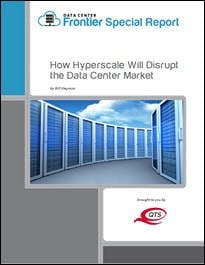This is the second of three entries in a Data Center Frontier series that explores how hyperscale will disrupt the data center market. This series, compiled in a complete Guide, also covers understanding major hyperscale trends and the elements of a hyperscale data center. This post focuses on how to select the right hyperscale partner.
Download the full report.
The rapid pace of our evolving infrastructure is forcing data center administrators to make infrastructure decisions at a blistering pace. In fact, many organizations are re-creating their business plans around the direct capabilities of the modern data center. Here’s the important piece to understand—the proliferation of cloud computing IT consumerization has created the need for powerful, hyperscale data center platforms. That means your infrastructure must be able to handle an increased density for new types of workloads.
All of these trends are fueling the push for more efficient data center utilization and more specifically, the deployment of hyperscale data centers. Organizations must work with the right type of partner to help them stay agile and resilient. The data center is becoming a truly integral part of any company. And, at the heart of the IT infrastructure, a hyperscale data center must be capable of scaling with the needs of the business. However, not all data centers are created equally, and many cannot customize a solution to best fit your hyperscale needs.
Hyperscale is now a mainstay in the data center landscape and true hyperscale partners are continually working to create data centers that are suited to meet rapidly evolving requirements. These requirements aim to solve the challenges revolving around traditional environments, help companies create faster go-to-market strategies, and help simplify distributed computing environments.
The transition to cloud is happening faster than expected for 3 reasons:
- Complexity of the traditional environment
- Speed to market requirements
- Simplification of compute environments
This is why it’s so important to work with a data center provider which can understand your business and deliver true hyperscale solutions.
“It is a full-time job to stay up to date with your managed services, hosting, clouds and colocation environments,” said Brian Johnston, QTS Chief Technology Officer. “When it comes to cloud, management, and critical visibility requirements, QTS takes a truly evolutionary—hyperscale—approach.”
“A customer portal has traditionally served as the mechanism to view an IT environment, however (like with most things) we need more,” Johnston adds. “QTS recently launched our automated service delivery platform, which leverages digitization and service-based integrated technology that delivers optics and controls that maximize performance through a single pane of glass.”
“Technically speaking, we have created set of disciplines that go beyond real estate,” adds Johnston. “In fact, QTS has provided more than just space and power from the very beginning —spanning over 10 years of hyperscale deployments. We have a deeper understanding and appreciation of what challenges hyperscale providers face because we have those same obstacles from a deep understanding of networking and fiber, to being a responsible consumer of energy and a sustainability. Simply put, we are more equipped to better impact hyperscale customers because we are already operating at the speed of the Internet, and we can have sophisticated conversations about occupancy, scale, and hyperscale requirements.”
[clickToTweet tweet=”When it comes to cloud and new initiatives, data is the lifeblood of any organization. #datacenters” quote=”When it comes to cloud and new initiatives, data is the lifeblood of any organization. #datacenters”]
When it comes to cloud and new initiatives, data is the lifeblood of any organization, and the hyperscale data center has become the heart. Managers demand new technologies to help their organizations respond to changing business conditions with agility and flexibility. As a result, hyperscale data center trends are evolving rapidly and spending is increasing, especially in multi-tenant environments. Plus, with virtualization and cloud computing in the mix, it is more important now than ever to have the right hyperscale partner in place.
New hyperscale technologies are paving the way for more efficient environments capable of scaling with business demands, and hyperscale organizations must be ready to do the same. Data-on-demand is the new norm where more information is being accessed at any given time. To deliver on real-world cloud and data requirements, hyperscale data center may very well be the way to go.
This series on hyperscale data centers will also cover the following topics:
- Elements of a Hyperscale Data Center
- How Hyperscale Will Disrupt the Data Center Market
- Elements of a Hyperscale Data Center
You can also download the complete report, “Data Center Frontier Special Report: How Hyperscale Will Disrupt the Data Center Market,” courtesy of QTS.
About the Author




